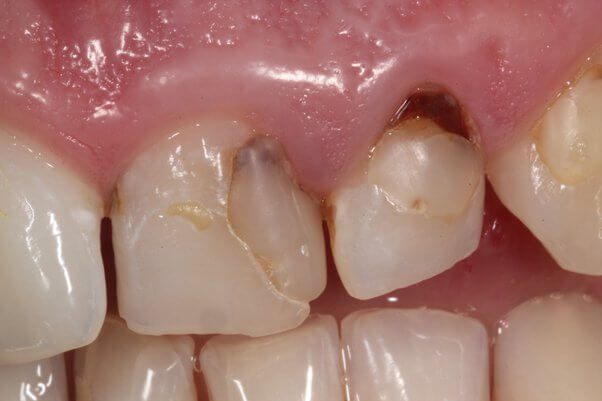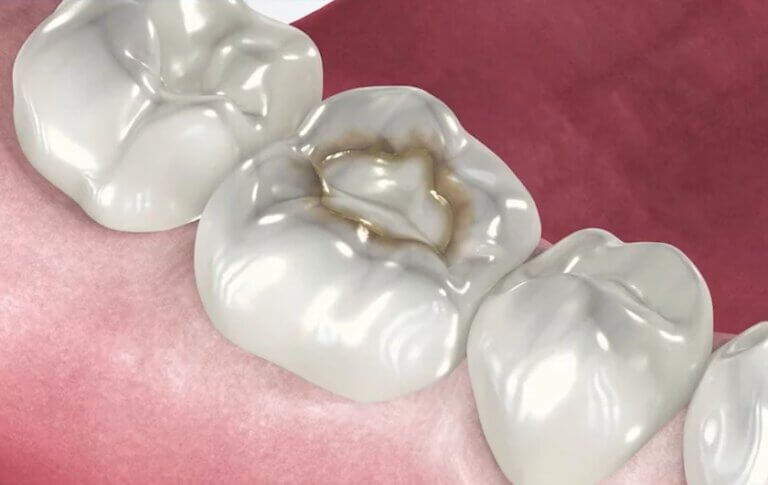Discolored Filling

What Is A Discolored Filling?
Dental fillings are a common treatment for cavities and decay. They are typically made of a composite resin material that blends in with the color of your natural teeth, leaving your smile looking healthy and vibrant. However, over time, fillings can become discolored and stand out from the surrounding tooth enamel. This can happen for a variety of reasons, including staining from food and beverages, aging of the filling material, and wear and tear from daily use. Discolored fillings can be a cosmetic concern, but they can also impact the health and function of your teeth. Before you contact a Toronto dentist to examine a Discolored Filling, there are some things you should know as a patient:
- Why Do I Have Discolored Fillings?
- Signs And Symptoms Of Discolored Fillings
- Treatment Options For Discolored Fillings
- How To Prevent Discolored Fillings
- Managing Discolored Fillings Until You Can See The Dentist
If you have questions about Discolored Fillings or other dental problems, please contact us for more information.
Why Do I Have Discolored Fillings?
There are several reasons why you might have discolored tooth fillings. Here are a few common causes:
- Staining from food and beverages: Over time, certain foods and drinks can stain the surface of your teeth and dental fillings, leaving them looking discolored. This can include coffee, tea, red wine, and dark-colored fruits and vegetables.
- Aging of the filling material: The composite material used for dental fillings can absorb moisture and stains and begin to discolor over time, especially if you have had the filling for many years.
- Wear and tear: Dental fillings are designed to withstand the forces of biting and chewing, but they can still experience wear and tear over time. This can cause the filling material to become chipped, cracked, or dislodged, leading to discoloration and other issues.
- Poor oral hygiene: If you do not brush and floss regularly, bacteria can build up around your dental fillings and cause them to become discolored. This can also increase your risk of developing new tooth decay.
- Tooth decay under a filling: Dental decay can cause a gray or black colored discoloration of the affected tooth. The bacteria responsible for tooth decay produce acids that can dissolve the tooth enamel and cause cavities. If left untreated, the cavity can progress and become larger, and may require dental fillings or root canal treatment.
- Smoking: Tobacco use can stain your teeth and dental fillings, leaving them looking yellow or brown.
By understanding the causes of discolored fillings, you can take steps to prevent them and keep your teeth looking healthy and vibrant. If you have further questions about what causes Discolored Fillings, please contact us.
Signs And Symptoms Of Discolored Fillings
If you have discolored tooth fillings, you may notice one or more of the following signs and symptoms:
- Dark or yellowish discoloration: Your dental fillings may look noticeably darker or yellowish compared to the surrounding tooth enamel. The underlying natural tooth material may also appear discolored, giving the appearance of a discolored tooth.
- Rough or uneven surface: Old discolored fillings can become rough or uneven over time. Cracks or chips can also appear. This is often a consequence of normal wear and tear, which can make them more prone to collecting plaque and bacteria, as well as make them susceptible to more damage.
- Sensitivity or tooth pain: If your filling has become damaged or worn down, it may expose the sensitive inner dentin layers of your tooth, causing pain or sensitivity to hot or cold temperatures.
If you are experiencing any of these symptoms, it’s important to schedule an appointment with your dentist as soon as possible. They can evaluate the health and integrity of your dental fillings and recommend appropriate treatment options to restore your smile. If you have further questions about the signs and symptoms of Discolored Fillings, please contact us.

Treatment Options For Discolored Fillings
If you have discolored tooth fillings, there are several treatment options available to help restore the appearance and function of your teeth. Here are a few options your dentist may recommend:
- Replacement of the filling: If your filling has become discolored or damaged, your dentist may recommend replacing it with a new brand filling made of a more durable or aesthetically pleasing material.
- Teeth whitening: If the discoloration is a consequence of natural tooth material becoming discolored and not the filling itself, teeth whitening may help to improve the appearance of your smile.
- Porcelain veneers or dental crowns: If your filling is large or your tooth is severely damaged or discolored, your dentist may recommend a porcelain veneer or dental crown to cover the affected tooth and restore its appearance and function.
Your dentist will evaluate your unique situation and recommend the treatment option that is best for you. By restoring your discolored fillings, you can improve the health and appearance of your smile and enjoy greater confidence in your daily life. If you have further questions about treatment options for Discolored Fillings, please contact us.
How To Prevent Discolored Fillings
Preventing discolored dental fillings is key to maintaining a healthy and vibrant smile. Here are a few tips to help you prevent discoloration and maintain the longevity of your dental fillings:
- Brush and floss regularly: Good oral hygiene is essential for preventing discoloration and decay around your dental fillings. Be sure to brush your teeth twice a day and floss at least once a day. The Waterpik waterflosser is also a terrific adjunctive tool to keep the area around the tooth filling clean.
- Use whitening toothpaste: Using whitening toothpastes such as Colgate Optic White Renewal or Crest 3D White can significantly reduce tooth and filling discoloration over time. The active ingredients are a patented hydrogen peroxide formula that is safe for enamel and will also whiten your teeth. They can be purchased at your local pharmacy or online.
- Limit stain-causing foods and drinks: Certain dark colored foods and drinks can stain your teeth and dental fillings, so it is a good idea to limit your consumption of coffee, tea, red wine, and dark-colored fruits and vegetables.
- Avoid smoking: Tobacco use is a major contributor to tooth discoloration and decay, so it’s best to avoid smoking or using other tobacco products.
- Choose the right filling material: If you need a new dental filling, talk to your dentist about the best material options for your unique situation. Some materials may be more resistant to discoloration and wear than others.
- Use a drinking straw: When drinking beverages that can stain your teeth and fillings, using a straw can help minimize contact between the liquid and your teeth.
- Schedule regular dental checkups: Regular dental checkups and teeth cleanings can help your dentist catch potential problems early on, before they have a chance to develop into more serious issues.
By following these tips and working with your dentist to maintain good oral health, you can help prevent discolored fillings and enjoy a bright and healthy smile for years to come. If you have further questions about how to prevent Discolored Fillings, please contact us.
Managing Discolored Fillings Until You Can See The Dentist
If you notice discolored dental fillings and are unable to see your dentist right away, there are a few things you can do to manage the situation and minimize discomfort:
- Practice good oral hygiene: Brush your teeth twice a day with a soft-bristled toothbrush and fluoride toothpaste. Floss daily to remove plaque and food particles from between your teeth and along the gum line. The Waterpik waterflosser is also a terrific adjunctive tool to keep your teeth healthy and clean.
- Use whitening toothpaste: Using whitening toothpastes such as Colgate Optic White Renewal or Crest 3D White can significantly reduce tooth and filling discoloration over time. The active ingredients are a patented hydrogen peroxide formula that is safe for enamel and will also whiten your teeth. They can be purchased at your local pharmacy or online.
- Try an at-home teeth whitening kit: Over-the-counter whitening kits, such as Crest 3DWhitestrips, can help remove surface stains and lighten the color of your teeth. However, it is important to follow the instructions carefully and note that results may vary. At home whitening kits may not have the same results as professionally applied teeth whitening gels.
- Avoid smoking or using tobacco products: Smoking and using tobacco products can cause yellow or brown stains on teeth, as well as other oral health problems.
- Limit staining foods and beverages: Foods and beverages such as coffee, tea, red wine, and dark-colored berries can stain teeth over time. It’s important to consume these in moderation and to rinse your mouth with water or brush your teeth after consuming them.
- Use a drinking straw: When drinking beverages that can stain your teeth, using a straw can help minimize contact between the liquid and your teeth.
While these strategies can help to manage discomfort associated with discolored fillings, it’s important to see your dentist as soon as possible to address the underlying issue and prevent further damage. If you have further questions about how to manage Discolored Fillings, please contact us.

